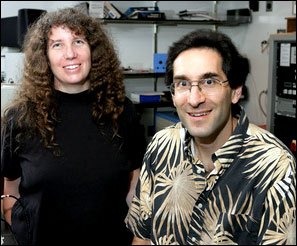
Light Source Brightened
LOS ANGELES, Sept. 20, 2007 -- A brighter polarized light source for LEDs in laptop computers, cell phones and other consumer electronics devices could be the result of new research.
University of California Los Angeles (UCLA) chemists working at the nanoscale said they have developed an inexpensive means of forcing luminescent polymers to give off polarized light and of confining that light to produce polymer-based lasers. The research was conducted by UCLA professors of chemistry and California NanoSystems Institute members Sarah Tolbert and Benjamin J. Schwartz, and colleagues, including Hirokatsu Miyata, a research scientist with Canon's Nanocomposite Research division in Japan.

Sarah Tolbert and Benjamin J. Schwartz, UCLA professors of chemistry and California NanoSystems Institute members (Photo courtesy UCLA)
The researchers have succeeded in taking semiconducting polymers -- plastics that consist of long chains of atoms that work as semiconductors -- and stretching them out in a silica (glass) host matrix so that they have new optical properties.
"If you have polymer chains that can wiggle like spaghetti, it's hard to make them all point in the same direction," Tolbert said. "What we do is take tiny, nanometer-sized holes in a piece of glass and force the polymer chains into the holes. The holes are so small that the spaghetti chains have no space to coil up. They have to lie straight, and all the chains end up pointing in the same direction."
Because the chains point in the same direction, they absorb polarized light and give off polarized light. Lining up the polymer chains also provides advantages for laser technology, because all the chains can participate in the lasing process, and they can make the light polarized without the need for any external optical elements, Tolbert said.
As a postdoctoral fellow, Schwartz was one of the original discoverers in the 1990s that lasers could be made out of randomly oriented semiconducting polymer chains.
"Our new materials exploit the fact that the polymer chains are all lined up to make them into lasers that function very differently from lasers made out of random polymers," Schwartz said.
The manner in which the polymer chains incorporate into the porous glass of the silica matrix helps to confine the light in the material, enhancing the lasing process by producing what is known as a "graded-index waveguide." In most lasers, confining the light is typically done with external mirrors.
"Our materials don't need mirrors to function as lasers, because the material that's lasing is also serving to confine the light," Schwartz said.
In combination, the alignment of the polymer chains and the confinement of the light make it 20 times easier for the new materials to lase than if a randomly oriented polymer sample were used. And because polymers can be dissolved easily in solvents, they are inexpensive to process. The glass host matrix with the aligned nanoscale pores is also inexpensive to produce.
"Usually polarized and cheap don't go together," Tolbert said.
The research could lead to potential applications for the new materials as a brighter polarized source for displays in products with LED-type displays, including cell phones, laptops and PDAs.
"If you take an inexpensive light source with which you could excite the aligned polymer chains and get the chains to reemit, you potentially have a more efficient way to generate polarized light." Tolbert said. "This would allow displays to be brighter with less power consumption, and you could get longer battery life."
The research is federally funded by the National Science Foundation and the Office of Naval Research and privately funded by Canon. It currently appears in Nature Nanotechnology online.
Tolbert has collaborated with Canon for years on the development of this class of new materials.
In addition to Tolbert, Schwartz and Miyata, co-authors include UCLA researcher and former postdoctoral scholar Ignacio Martini, UCLA chemistry graduate student Ian Craig, and UCLA chemistry graduate student William Molenkamp. The five UCLA co-authors are all members of the UCLA Materials Creation Training Program (MCTP). Martini runs the laboratory, Tolbert and Schwartz are MCTP faculty, and Craig and Molenkamp are MCTP trainees.
For more information, visit: www.ucla.edu
Published: September 2007